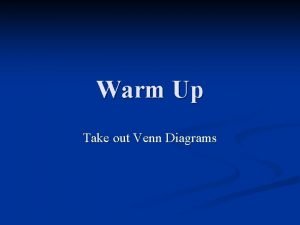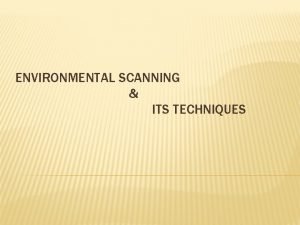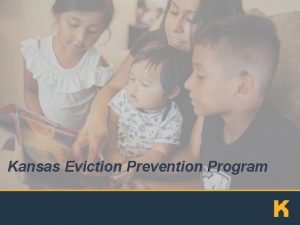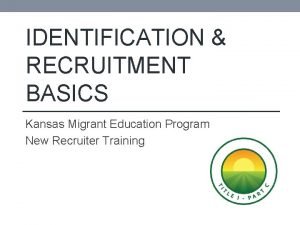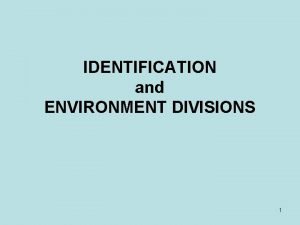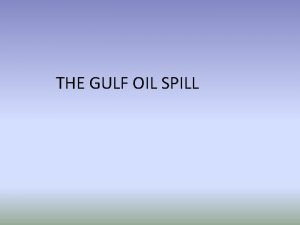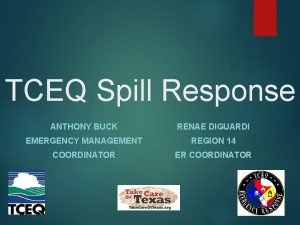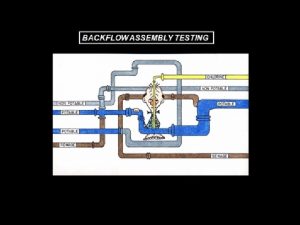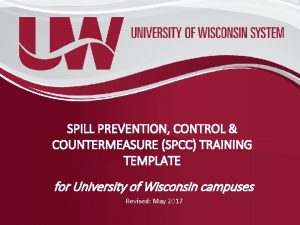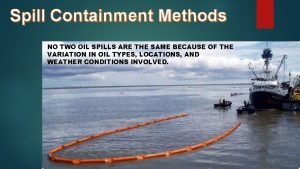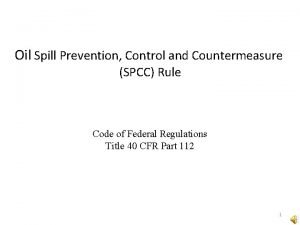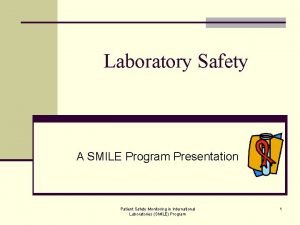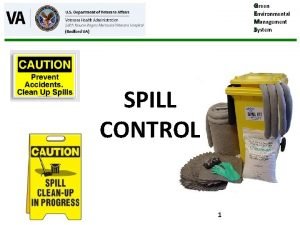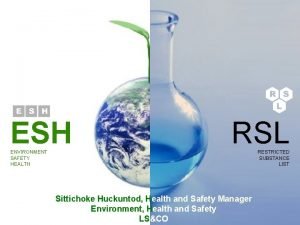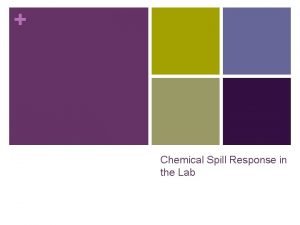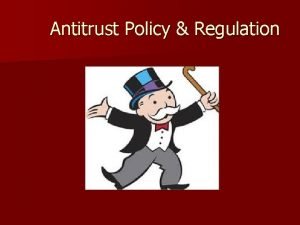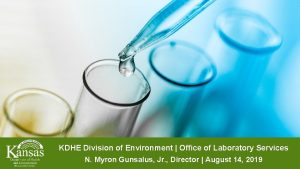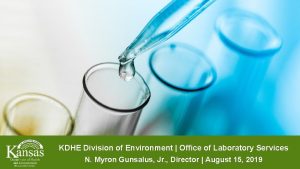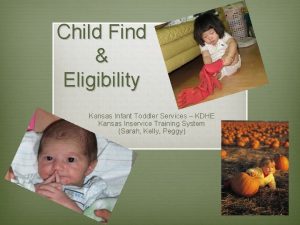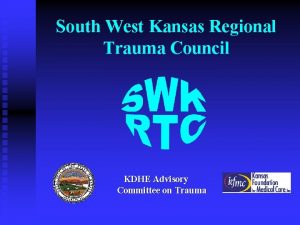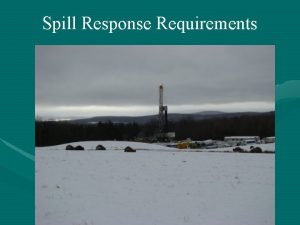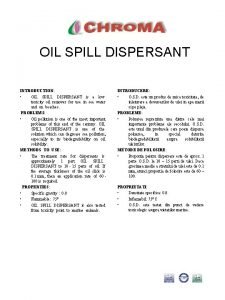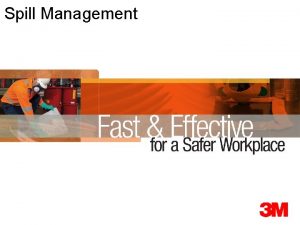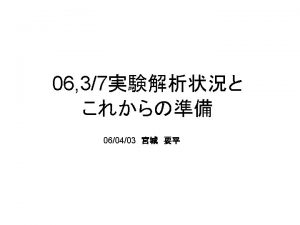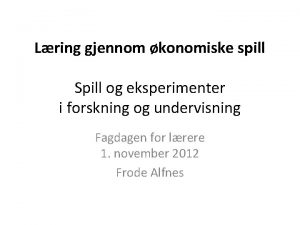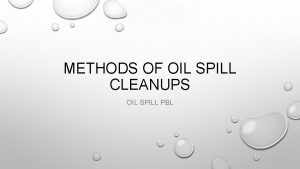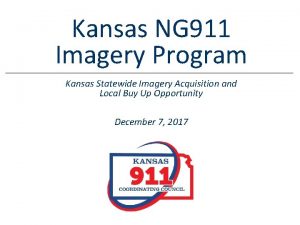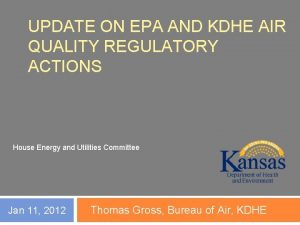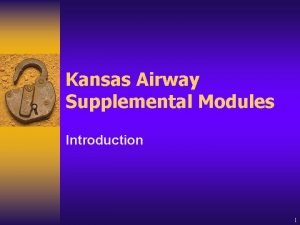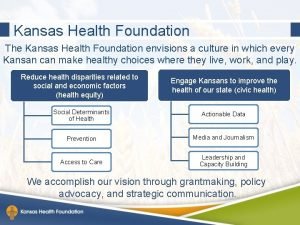KDHE Division of Environment Kansas Spill Program Proposed
























- Slides: 24

KDHE Division of Environment Kansas Spill Program Proposed Rule Revisions August 8, 2018

Division of Environment KDHE Spill Reporting Instructions kdhe. Spill. Hotline@ks. gov (785) 291 -3333 Jeff Janzen Spill Program Coordinator (785) 368 -7301 jeffery. janzen@ks. gov

Division of Environment K. S. A. 65 -171 d. – Prevention of Water Pollution (a) For the purpose of preventing surface and subsurface water pollution and soil pollution detrimental to public health or to the plant, animal and aquatic life of the state, and to protect designated uses of the waters of the state and to require the treatment of sewage predicated upon technologically based effluent limitations, the secretary of health and environment shall make such rules and regulations, including registration of potential sources of pollution, as may in the secretary's judgment be necessary to: (1) Protect the soil and waters of the state from pollution resulting from underground storage of liquid petroleum gas and hydrocarbons, other than underground porosity storage of natural gas; (2) control the disposal, discharge or escape of sewage as defined in K. S. A. 65 -164, and amendments thereto, by or from municipalities, corporations, companies, institutions, state agencies, federal agencies or individuals and any plants, works or facilities owned or operated, or both, by them; and (3) establish water quality standards for the waters of the state to protect their designated uses, including establishment of water quality standards variances that may apply to specified pollutants, permittees, or waterbody segments that reflect the highest attainable condition during the specified time period for the variance. In no event shall the secretary's authority be interpreted to include authority over the beneficial use of water, water quantity allocations, protection against water use impairment of a beneficial use, or any other function or authority under the jurisdiction of the Kansas water appropriation act, K. S. A. 82 a-701, and amendments thereto.

Division of Environment K. S. A. 65 -164. – Sewage 65 -164. (b) For the purposes of this act, "sewage" means any substance that contains any of the waste products or excrementitious or other discharges from the bodies of human beings or animals, or chemical or other wastes from domestic, manufacturing or other forms of industry.

Division of Environment K. S. A. 65 -171 v. – Cleanup Operation Whenever a water or soil pollutant is discharged intentionally, accidentally or inadvertently and the secretary of health and environment or his or her authorized representative determines that the discharged material must be collected, retained or rendered innocuous, and if a discharger refuses to undertake cleanup operations or if the responsible discharger is unknown at the time, the secretary or his or her authorized representative may enter into an agreement with a person to conduct the necessary cleanup operations with payment for such cleanup work to be provided from the pollutant discharge cleanup fund. Any person responsible for or causing the discharge of materials which are determined necessary to cleanup under the provisions of this act shall be responsible for repayment of the costs of cleanup work upon reasonably detailed notification by the secretary or his or her authorized representative. If the responsible person fails to promptly submit payment for costs of the cleanup operations when so notified, such payment shall be recoverable in an action brought by the attorney general on behalf of the people of the state of Kansas in the district court of the county in which such costs were incurred. Any moneys recovered under this section shall be remitted to the state treasurer. Upon receipt thereof, the state treasurer shall deposit the entire amount thereof in the state treasury to the credit of the pollutant discharge cleanup fund.

Division of Environment K. A. R. 28 -48. – Spill Reporting 28 -48 -2. Action required. All sewage, substances, materials, or wastes, as set forth in 65 -171 d, regardless of phase or physical state, which are, or threaten to contaminate or alter any of the properties of the waters of the state or pollute the soil in a detrimental, harmful, or injurious manner or create a nuisance, shall be reported in the following manner: (a) The owner or person responsible for the discharge or escape of materials detrimental to the quality of waters of the state or pollution of the soil under conditions other than provided by a valid permit issued by the secretary of health and environment, shall report the discharge or escape to the Kansas department of health and environment. (b) Emergency or accidental discharge of materials which are detrimental to the quality of waters of the state or tend to cause pollution of the soil shall be immediately reported to the Kansas department of health and environment by the owner, owner’s representatives, or person responsible. In the event the pollution causing material is in transit or in storage within the state, the owner, carrier, or person responsible for storage shall be responsible for immediate notification to the Kansas department of health and environment that the pollutant will gain admittance to the waters of the state or the soil. (Authorized by and implementing K. S. A. 1984 Supp. 65171 d; effective May 1, 1986. )

Division of Environment Statute Changes Under Consideration Combine under KSA 65 -171 v • Definitions • Duties of the Secretary • Responsibility to respond • Cost recovery & Penalties • Access

Division of Environment Proposed Statute Revisions - Definitions • “Pollutant” means any substance which causes contamination or alteration of the natural physical, chemical or biological properties of any waters or soils of the state as will or is likely to create a nuisance or render such waters or soils harmful, detrimental or injurious to public health, safety or welfare, or to the plant, animal, or aquatic life of the state or to other designated uses. • "Person" means any individual, owner, operator, corporation, limited liability company, partnership, association, municipality, state agency or federal agency. • "Release" means any threatened or real emission, discharge, spillage, leakage, pumping, pouring, emptying or dumping of a substance into or onto the land, air or waters of the state unless done in compliance with the conditions of a federal or state permit, or unless the substance is applied in accordance with the product label. • “Emergency” means any release which poses an imminent risk to public health or safety or welfare.

Division of Environment Proposed Statute Revisions - Duties of the Secretary Duties of the secretary • Make rules and regulations • Designate 24 hour reporting hotline • Provide oversight, technical guidance • Require responsible party to respond • Emergency actions to protect public safety

Division of Environment Proposed Statute Revisions - Responsibility to Respond • Person responsible shall give notice to the department • Person responsible shall cleanup release • If RP does not take reasonable response actions, Secretary may take any actions necessary & recover costs • Person responsible shall repay costs for cleanup and oversight

Division of Environment Proposed Statute Revisions - Access to property No person shall refuse entry or access to an authorized representative who presents appropriate credentials for the purpose of investigating or responding to releases, nor obstruct or hamper the representative. Prior notice of entry or access to the owner or occupant of private property is not required during emergencies if the delay attendant upon providing it will result in imminent risk to public health or safety or welfare.

Division of Environment Regulation Changes Under Consideration – Stakeholder Input Reportable Quantities Timeline for Reporting Historic Releases Cost Recovery & Penalties

Division of Environment Reportable Quantities? • Business practices for de minimis release reporting • e. g. Periodic submittal of non-PCB transformer oil releases by electrical utilities where release is easily and completely remediated • Reportable Quantities for different materials? • Petroleum? • Hazardous Materials? • Deleterious Materials? • Agrichemicals? • Releases to Soil? • Releases to Surface Water? • Releases to Groundwater?

Division of Environment Federal Reportable Quantities • Underground Storage Tank Regulations- 40 CFR 280. 53 (“Tanks Rule”) • Release of >25 gals of petroleum must be reported to implementing agency • Clean Water Act- 40 CFR 110. 3 (“sheen rule”) • Discharges that cause a sheen or discoloration on the surface of a body of water; Discharges that violate applicable water quality standards; and • Discharges that cause a sludge or emulsion to be deposited beneath the surface of the water or on adjoining shorelines. • Hazardous Substances (“List of Lists”) • Environmental Planning & Community Right to Know (EPCRA) § 302(a)(2) • Clean Air Act- 112(r) Regulated Chemicals for Accidental Release Prevention • CERCLA Hazardous Substances

Division of Environment States With Similar Spill Reporting Generally any amount of any substance harmful to the environment or public health

Division of Environment Neighbor States • Colorado: • >25 gallons petroleum on soil; “Sheen Rule” on water • Federal Reportable Quantities for hazardous materials • Missouri: • >50 gallons of petroleum on soil, >25 gallons petroleum from UST releases; • “Sheen Rule” on water • Any amount of hazardous material that might impact health or environment • Nebraska: • >25 gallons of petroleum on land; Any amount of petroleum on water • Federal Reportable Quantities, or >100 lbs; whichever is less • Oklahoma: • >10 barrels of any material used/produced during petroleum exploration; • “Tanks Rule” & “Sheen Rule”; • Federal Reportable Quantities for hazardous materials

Division of Environment Wisconsin example • RQ of 1 gallon for light grade petroleum (gasoline) • RQ of 5 gallons for medium or heavy grade petroleum (diesel or lube oils) • on permeable surfaces • Federal Reportable Quantities for hazardous materials • Agrichemical specific RQs: • 25 gal. of liquid fertilizer; • 250 lbs of dry fertilizer; • pesticides that would cover >1 acre of land if it is mixed for application per labeled instructions.

Division of Environment Reporting Requirements Regulations Proposal • Any release of a pollutant to surface waters • >5 gallons for light grade petroleum (gasoline) to soil • >25 gallons for any other liquids to soil • >100 lbs, or exceeds Federal Reportable Quantities for hazardous materials; whichever is less • >250 lbs of dry fertilizer

Division of Environment Reporting Deadline? 28 -48 -2. Action required. (b) Emergency or accidental discharge of materials which are detrimental to the quality of waters of the state or tend to cause pollution of the soil shall be immediately reported to the Kansas department of health and environment by the owner, owner’s representatives, or person responsible. In the event the pollution causing material is in transit or in storage within the state, the owner, carrier, or person responsible for storage shall be responsible for immediate notification to the Kansas department of health and environment that the pollutant will gain admittance to the waters of the state or the soil. • “immediate” is subjective and difficult to enforce • Don’t want the reporting requirement to interfere with emergency response actions necessary to protect life safety Life Safety → Incident Stabilization → Initiate Response Actions • Discoveries of historic releases

Division of Environment Reporting Time Regulation Proposal • Release must be reported to KDHE within 15 minutes of discovering or gaining knowledge of the event and the completion of the initial response • Discovery of historic contamination • Current property owner must make the notification to KDHE

Division of Environment Response Actions Regulation Proposal • Require response actions be completed by the responsible party regardless of the volume of the release or notification requirement • Cleanup must be completed under KDHE oversight • Referral to traditional cleanup program for oversight • Initial response vs. longer term assessment and remediation oversight needs

Division of Environment Penalties Regulation Proposal • Proposed penalty range of $25 -$10, 000 - consistent with KSA 65 -3444 Hazardous Waste Statutes − Illegal dumping − Lack of, or refusal to take timely action − KDHE perform work and cost recover − Lack of timely reporting − Under-reporting (significantly less volume or intent to take advantage of reporting requirements)

Division of Environment Next Steps • Legislative Initiative for the proposed Statute revisions (in progress) • Present recommendations to Stakeholders • Draft proposed regulations Director of Budget – Economic Impacts. Dept of Admin – Organization and grammer • Public Notice & Hearing • Publication in Kansas Register Atty. General Legality

Division of Environment Comments / Questions? kdhe. Spill. Hotline@ks. gov (785) 291 -3333 Joseph Dom, Chief Assessment and Restoration Section Bureau of Environmental Remediation (785) 296 -1914 joe. dom@ks. gov
 Kansas kansas state fight
Kansas kansas state fight Environment scanning techniques
Environment scanning techniques Monash study away
Monash study away Kansas assessment program
Kansas assessment program Kansas eviction prevention program 2021
Kansas eviction prevention program 2021 Kansas migrant education program
Kansas migrant education program Financial environment in business environment
Financial environment in business environment Environment division in cobol
Environment division in cobol Identification division in cobol
Identification division in cobol Short division vs long division
Short division vs long division Synthetic division pattern
Synthetic division pattern Long division worksheets
Long division worksheets Divide using long division
Divide using long division Exxon
Exxon Tceq spill reporting
Tceq spill reporting Spill resistant vacuum breaker
Spill resistant vacuum breaker Spill prevention control and countermeasure plan template
Spill prevention control and countermeasure plan template Oil spill containment methods
Oil spill containment methods Oil spill
Oil spill Raft chemical spill acronym
Raft chemical spill acronym Chemical spill response flow chart
Chemical spill response flow chart Chemical spill
Chemical spill Chemical spill
Chemical spill Oil spill
Oil spill A spill at parsenn bowl knee injury and recovery
A spill at parsenn bowl knee injury and recovery
